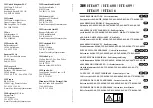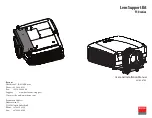
2240 SRM 1
Battery Maintenance
6.
When maintenance on the battery or the battery
charger is required, disconnect both the AC and
DC power. If the battery connectors must be re-
placed, make sure the positive and negative ter-
minals and cables are kept separate and insu-
lated from each other. Even a momentary short
circuit can cause an explosion and damage the
battery.
7.
Keep water readily available to flush spilled elec-
trolyte. Electrolyte in the eyes must be flushed
with water immediately, and then quickly get
medical attention.
Special showers and eye
wash systems are required in areas where bat-
tery maintenance is done.
8.
If electrolyte is spilled on a work surface or the
floor, flush area with water, use a solution of soda
(sodium bicarbonate) to make the acid neutral.
9.
Only trained persons are permitted to do main-
tenance on batteries and battery chargers. Make
sure the regulations by government safety agen-
cies, government insurers, private insurers, and
private organizations are followed when doing
maintenance on batteries.
MAINTENANCE RECORDS
NOTE:
Follow the same sequence when you record
the cell number. Always begin the record with a pos-
itive cell. Follow a sequence so the last cell is always
the cell for the negative cable.
Record the beginning ampere reading of the charger
each time the battery is charged. Any difference in
the daily ampere reading can indicate a problem with
the battery or the charger.
NEW BATTERY
CAUTION
Always use a spreader bar and slings that lift
vertically on the lifting eyes of the battery. DO
NOT use a chain or sling without a spreader
bar or you will damage the battery case.
Use the correct blocks or spacers to hold the
battery in position in the lift truck. Make sure
the battery compartment is clean and dry. All
vent caps must be in position when the battery
is in service. If the vent caps are not installed,
the electrolyte will leak, causing corrosion on
the battery case and in the battery compart-
ment.
Inspect a new battery for damage. Make sure the
electrolyte in each of the cells is at the correct level.
Charge the battery for 6 hours or until the specific
gravity is correct. Make sure the battery is correctly
installed in the lift truck. Use a spreader bar with
slings designed for the battery to lift and move the
battery. See Figure 10.
Always complete the Battery Inspection Report and
the Daily Battery Report. See Figure 11 and Fig-
ure 12.
CLEANING BATTERY
WARNING
Compressed air can move particles so that they
cause injury to the user or to other personnel.
Make sure that the path of the compressed air
is away from all personnel.
Wear protective
goggles or a face shield to prevent injury to the
eyes.
Keep the battery compartment clean and dry. Use a
clean cloth to wash the battery with water. Dry with
compressed air.
CAUTION
Do not clean the battery with steam or hot wa-
ter. Do not use a high-pressure hose.
Remove any electrolyte from the battery compart-
ment to prevent corrosion. If there is electrolyte on
the top of the battery, apply a solution of bicarbonate
of soda. Mix a solution containing 0.5 kg of soda for
every 4 liters of water. Apply the solution, then flush
the solution from the battery with clean water. Wash
the battery and battery compartment as needed, but
within a 6-month period as the maximum time.
NOTE:
If the top of the battery is wet from electrolyte,
check that the electrolyte level is not too high or the
battery charger is not operating correctly.
7








































